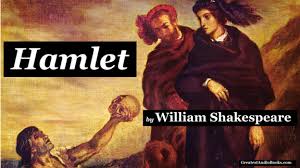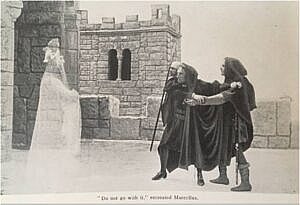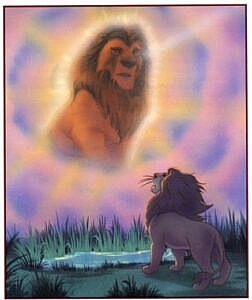I have already discussed Hamlet and Lion King, in this article about the similarities. If you haven’t read “Hamlet – Part 1” and “Hamlet – Part 2” click the link and read.
Similar Scenes and dialogue
In the very opening scene of The Lion King Mufasa, the king of the Pride Lands confronts his brother Scar. Scar has just missed the presentation of Simba, Mufasa’s son who is to be the next king. Scar turns as if to leave and Mufasa stops him by saying “Don’t turn your back on me Scar.” This is a warning. Scar shoots back “No, perhaps you shouldn’t turn your back on me!” This is a veiled threat to the king’s life. Because the king is never introduced in Hamlet, the audience is left to wonder whether the king had any notice that his brother wanted him dead. The play starts with Claudius and Gertrude marriage.
Scar plans to kill both Simba and Mufasa. To kill Simba, Scar sets a trap. After making Simba stand in the trap, Scar calls Mufasa to help Simba. To save the life of his kid, Mufasa rushes to the place and saves Simba. Mufasa dies saving Simba. Scar uses the situation properly to convince Simba to go from Pride Lands. Later Scar addresses the lionesses that he feels bad for the tragedy, Mufasa’s death and the loss of Simba. Claudius addresses other people in the Kingdom that his memories with Hamlet are still fresh and it is Claudius and the kingdom to grieve for him.
Scar takes up the throne along with the hyena with his heavy heart because of the death of the King. Claudius makes a sarcastic comment in the sad joy, with laughter in funerals and grieving in weddings. He marries his sister in law and makes her his queen. Both the characters are jealous of the throne. They act to their in-laws to win the throne. Claudius married Gertrude because of the king’s rule.
Ghost
King Mufasa as Ghost makes Simba realise who he is and asks him to get back to his place and take up his position in the circle of life. But king Hamlet as Ghost tells Hamlet that his death is unnatural. King Hamlet asks to take revenge on the person who murdered him. Also reveals to him that the person who killed him now wears the crown. He was only guided to take revenge for his father’s death.
Mufasa makes Simba stronger by his words that he is the son of Mufasa and the only true king. King Hamlet says Hamlet that if he is the true son of him he shouldn’t leave the murderer. Both kings strongly emphasize the word “Remember.” Mufasa asks Simba to remember who he is but King Hamlet wants his son to remember who he is and revenge for his death. Simba was not sure what he should do on returning to the “Circle of life” and how to face everything that all these days he has run out. But then decides to go back to the Pride Lands. Hamlet to make sure whether the clue given by Ghost is true or not, stages a play.
Scar tricks and makes Simba tell him the reason for Mufasa’s death as he already made him believe and decides to kill Simba in front of lionesses as a murderer. Claudius makes use of Laertes to kill Hamlet as revenge for his father Polonius’ death.
Scar confesses the truth about the murder of Mufasa to Simba when he is hanging at the edge like Mufasa. Claudius also confesses about the murder of king Hamlet when he was praying. In the end, Simba tells Scar to run away and never return to Pride Lands for killing his father, Hamlet when knows about the venom in the knife, kills Claudius with it. Simba takes up his position as king of Pride Lands as he was guided by his father. Hamlet says to Horatio that he wishes Fortinbras to win the election and take up the Kingdom.
Death
The death of Simba’s father and Hamlet’s father leaves both in a melancholy disposition and not knowing where to turn. It left both of them with a sense of responsibility. Though it took Simba a longer time to realize this sense, it was mainly due to Simba’s knowledge of Scar ruining the kingdom, not as the murderer, which he finds out toward the end. Simba continually contemplates his life under “Hakuna Matata” versus his life in the Pridelands – thinking of himself as dead to the Pridelands, while Hamlet has similar views of being held captive, as good as dead, in Denmark. Hamlet was in a mad state to live or to die. Inevitably, both characters accept their charge and seek to overcome their uncles to restore honour, integrity, responsibility, and respect to their kingdoms.
Hamlet was motivated with revenge, but Simba was guided by his Father’s spirit and Rafiki to get back to his position as king of Pride Lands and indirectly to revenge for his father’s death. The Lion King can be reckoned as the modern interpretation of Shakespeare’s classic literary work but there’s no denying that it offers a more fulfilling ending whereas Hamlet is purely a filial tragedy.
In one of the most innovative and creative adaptations of Hamlet, The Lion King goes beyond what a traditionally animated feature does – it transcends not only generations, but also themes, characters, traditions, and moral obligation to depict the importance of responsibility and moral integrity.
Disney’s The Lion King was perhaps one of the most innovative, creative, and uniquely potent adaptations of Hamlet ever done. While the themes of responsibility, revenge, and madness pervade Shakespeare’s version, the same can be said for Disney’s edition. The characters bear a striking resemblance to those in the animated feature – each lion follows the mould etched out in the original text.
Conclusion
There are several diversions from the original text and plot that make the outcome and the storyline slightly different, yet maintain the integrity of Shakespeare’s writings. The first important difference is that the story begins with Mufasa being alive and well. Rather than hear second hand about the king’s murder, as we do in Hamlet, we watch it as it happens. Most importantly, the play ends as a tragedy – Hamlet dies, the king dies, the queen dies, and Hamlet’s love interest dies, all the while a foreign prince takes over the throne of Denmark. On the contrary, the animated film concludes with the rightful king retaking power after the usurper is killed, the queen surviving and ceding power to the prince’s love interest, and the kingdom restored to its past success.
Subscribe to our email newsletter to get the latest posts delivered right to your email.



Comments